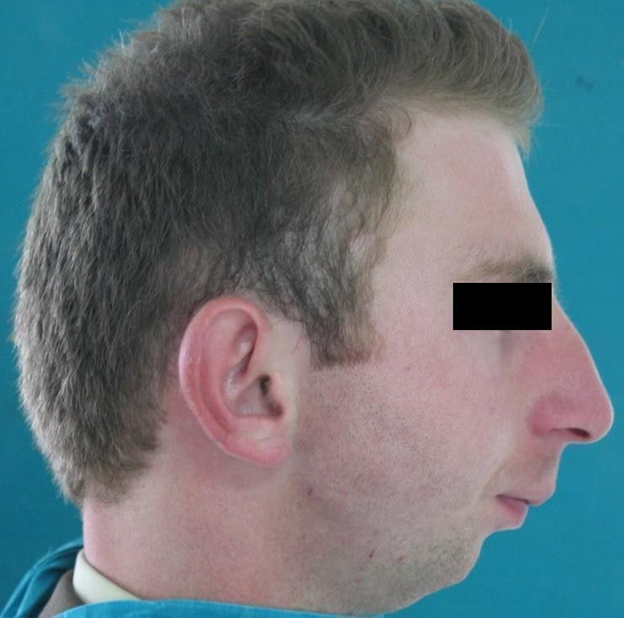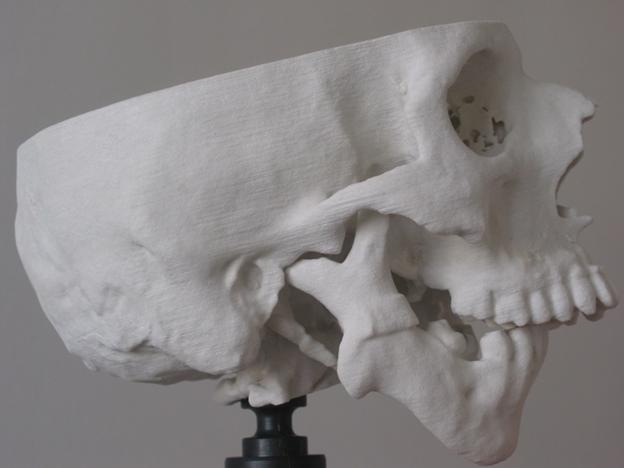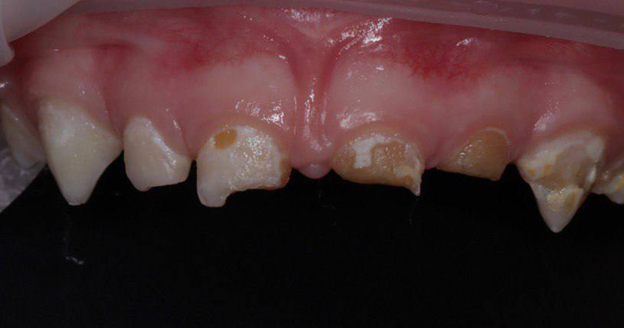
Children are just full of teeth. The teeth somehow fit in the skull, but still almost stick out in the nostrils and eye sockets. Here, for example, there are 48 teeth at the same time, and this is an absolutely healthy patient.
Milk teeth are very important. We have repeatedly encountered the reaction of parents in a situation when they bring a child with advanced multiple caries. “How much will it cost to cure eight teeth? No, I will not, they will rip everything out for free under the compulsory medical insurance. Unfortunately, parents often do not understand that the loss (or loss) of baby teeth is very critical for the formation of a healthy orthognathic bite.
The chain is pretty simple:
- The tooth was removed much earlier than the date of its change.
- Adjacent teeth turned and tilted to close the defect.
- The growth of the jaws slowed down or stopped, as they depend on the chewing load.
- Permanent teeth erupted with defects, as the rudiments are damaged by infection.
- In adolescence, we have complex dentoalveolar anomalies and very, very expensive orthodontic treatment, which took years to fix.
Therefore, today I will tell you what you need to do from the free one with the child at the start, so that later you do not spend a lot of money and energy on treatment in the future.
How many teeth does a child have

A set of teeth in a child of six and a half years old. The first chewing permanent teeth have appeared, but the incisors have not yet erupted.
If you do not take supernumerary "bonus" teeth, then a person usually has 28–32 permanent teeth and 20 milk teeth. That is, at the moment shortly before the first change of teeth, the child has up to 52 teeth in the jaw at the same time. I am still amazed when I see X-rays of the jaws of children six to nine years old. Sometimes there is a feeling that there are more teeth than the jaw itself.
The skull in children has a peculiar shape. It is difficult to pass through the birth canal, the pelvis is narrow, and the head is rather big. We need to save on something so as not to get stuck on the road. It is not particularly possible to save on brains. They should be sufficiently developed right away. As a result, evolution came to the mechanism of movable bones of the skull, which run over each other like shingles. The real savings in head size come from the front of the skull. Children have very small upper and lower jaws, teeth - in the form of tiny rudiments. This allows us to be born with minimal problems, but it also means that we need to grow these very jaws over the next few years of life. And this is where the difficulties begin.
The growth of the jaw in width is regulated primarily by the load. And this is where parents often make two important mistakes.
In the beginning, they often choose a nipple with a large hole when giving up breast to make it easier for the baby to eat. And children are very lazy. If they understand that they can no longer pretend to be a vacuum installation, trying to eat everything that was synthesized in their breasts, then they quickly begin to spit at the sight of a natural nipple and demand a bottle. The effort required for sucking is very high. It is not for nothing that children have such huge cheeks due to Bish's fat lumps. There is a theory that they need hamster cheeks so that the tissues can withstand the sucking process without consequences. And a little to warm the head with brown fat.
The second error occurs when a child has the first teeth. At this age, they are very curious and try everything they see. Especially if one of the parents is eating it in front of them. At friends, the child cracked a hefty piece of shish kebab per 100 grams when the adults turned away. Moreover, the teeth were so far only the upper ones. This did not bother him, and he simply removed the shavings from him, like a lathe. In general, this is a normal process. Problems begin when a child chokes on a slice of apple or carrot a couple of times. Nervous parents immediately return to mashed potatoes and chopped foods. And children are lazy, as you remember. Chewing is difficult, you have to strain. Very quickly, a one-year-old child can begin to pretend his painful death from a terrible piece of pear and demand homogeneous porridge and mashed potatoes.
Jaws do not grow due to soft food

One of the options for the underdevelopment of the lower jaw. A specific " bird " profile.

The same patient. Skull stereolithography .
Reducing the load below the intended one leads to two very unpleasant consequences. The jaws begin to lag behind in development. As a result, the lower and upper micrognathia is formed - the underdevelopment of the jaws. The photos above show a very hard case. This is most often the result of concomitant genetic disorders. But even on a less impressive scale, this is a wild headache for orthodontists. You can simply move and tilt individual teeth. It is almost impossible to correct the position and size of the jaws, especially in adulthood. You will have to break bones, reshape the position of muscles, joints, tongue, and much more.
Soft food will cause caries
This is the second consequence of feeding exceptionally soft cereals and mashed potatoes, when it is already time for the child to gnaw on solid food. A colleague has already talked about this in a post about tooth decay . When we chew hard stems, chew roots, we scrape off plaque. In addition, there is a micro-massage of the gums, which improves their blood circulation and prevents the formation of tartar under the gums. The child should chew intensively, and not drink instant cereals, jelly and banana puree.
As a rule, if you see a child with severe multiple caries, then almost certainly his diet is based on soft buns, cookies and all kinds of instant cereals. Well, in general, hygiene is also not very good.
How is the process of changing teeth going?

The process of forming the facial bones of the skull. Notice how the facial bones of the skull grow and the jaws grow larger .
In the process of development, our jaws gradually grow, freeing up space for permanent teeth. Children have a small skull and a lot of teeth. And everyone has to slide down in time to the side of the oral cavity along complex trajectories, starting the resorption of their milk predecessor. Root resorption is the process of dissolving the roots of deciduous teeth under constant pressure, which forms a constant.

Lower fourth milk tooth. The roots are in place, as you can see, since it was removed before the natural change .
Due to the fact that at one time we all spat out milk teeth without roots, many have the mistaken understanding that milk teeth, in principle, do not have them. And the indigenous ones are already permanent. In fact, they have normal roots, only they are usually spread out to the sides to make room for permanent bud. Often, as a result, parents think that they are almost trying to deceive them when it is necessary to clean and fill the canals of milk teeth. “What channels? These are milk teeth, there are not even roots there! " We have to show radiographs.

If we look at the orthopantomogram, we will see that the permanent teeth initially do not have a formed root. These are the so-called “hat” and “bell” phases. That is, when the tooth has just erupted, it does not have a thin exit from the root canal, but a hefty wide opening. The process of final root formation will only be completed a few years after eruption. This is a wild problem for the dentist if a tooth requires depulpation and work in the canals. Normal endodontics is almost impossible.
How caries works in a child


The most acute form of caries. Please note that there is no usual dark coloration. Tissues simply fall apart faster than they can accumulate pigment.
The course of caries in children is fundamentally different from that of adults. They have low mineralized enamel and very loose, permeable dentin. Bacteria synthesizing organic acids devour the tissues of milk teeth at an incredible speed, if only they managed to gain a foothold. There is almost never a classic chronic caries in children. Chronic caries is when it develops so slowly that it has time to stain with tea, coffee, cigarettes and borscht. As a result - the classic, familiar black dots on the teeth. If you probe them, then they give in, but still quite dense. But in children, caries is unpainted. Can not get in time. When probing, it resembles rotten wood, which crumbles in layers under the instrument. As a result, a little more than a month may pass from the beginning to the complete breaking off of the crown.
Because of its tenderness, the enamel of children is especially vulnerable to the malevolent microflora of the oral cavity of adults. The worst scenario is when a grandmother or grandfather with a mouthful of carious teeth tries to see if the child's food is hot with his own spoon. As if there is no other way to measure temperature. Even a finger would be better to dunk. Therefore, make sure that the child has his own separate spoon, which no one else uses except him.
Very often, when caries is detected, the question arises about the expediency of treatment. “Let's take it out, it's milk anyway! As a child, they pulled out all my teeth, anyway there is no point in treating. ” You look at your mother, and there is an impressive deformation of the bite and defects in the development of the jaws. In fact, it makes no sense to remove a carious tooth without any additional actions, if it is about to change anyway. In other cases, there are two options: we either treat fully, or remove a completely hopeless tooth, but come up with a temporary design to close the defect. Milk teeth need to work longer than they seem. The same canines change at the age of 12-14! And without them, the bite will simply move out, become asymmetrical. There will be inevitable deformities and joint problems.
It is also impossible not to heal. This is banally dangerous. The infection will go deeper and can destroy the germ that is permanent under a sore milk tooth. In a very severe form, the infection can result in phlegmon, mediastinitis and sepsis. Very wide spaces for its distribution in adipose tissue.
So, taking into account the speed of distribution, there can be no options "let's go like this for a couple of months". Moreover, there is already excellent anesthesia, and masks with nitrous oxide, and sevoflurane, if the case is neglected and you have to treat more than 10 teeth at a time. Fortunately, a well-coordinated team can deliver such a massive treatment in just a couple of hours. If you are interested, you can look at one of the past posts , a colleague there told in detail about nitrous oxide and anesthesia.
Prophylaxis
The classic question is: "When should I start brushing my teeth?" Immediately. From the very first erupted. Here, of course, you will have to select games with children, so that it does not turn into an unpleasant procedure. Let him try different versions of pastes, brush his teeth with a plastic horse, and the like. For the start, it is convenient to use silicone brushes that are put on the finger.
And you still need to keep an eye on them, even if they are already brushing their teeth. Believe me, they often brush their teeth badly. Buy a plaque indicator - this is such a dye. They can simply rinse out their mouth and rinse with water. Uncleaned plaque will remain brightly colored. Unfortunately, the language is for a while too. Therefore, you can simply apply it to your teeth with an ear stick.
Do not scare children with white coats.
Chat with your child. Save money on cleaning control - get a very expensive and complicated treatment in 15 years. Never scare him with a doctor. But there is no need to tell that it will not be painful at all, and the doctor will only look: the child will stop trusting in the end.
It will be best if you first bring your child to meet and ride on a chair. Better to let the first procedures be hygienic.
Additional materials

Source.

A source.
Licensing and Rights
All images are licensed under a Creative Commons Attribution-NonCommercial-ShareAlike 3.0 Unported License.
No Copyright - Non-Commercial use only.
memento.muttermuseum.org/page/about-memento-mutter
PS If you get to our clinics, then say that you are from Habr, there will be a 5% discount.